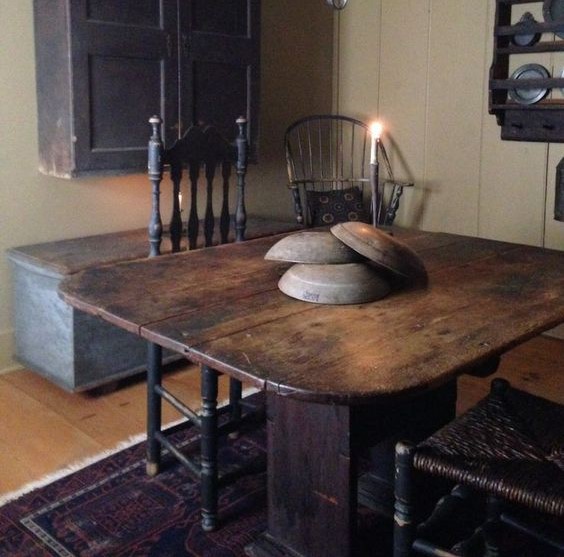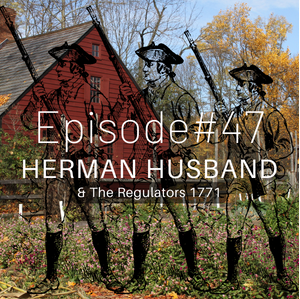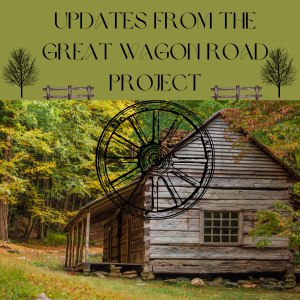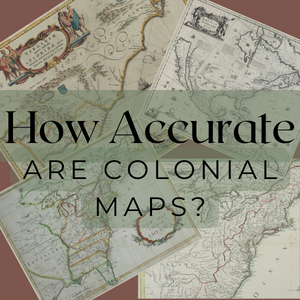Muddy Creek was originally named Gargals Creek and can be shown in this manner on the Fry-Jefferson map of 1755. The upper most branch is shown as Gargales Creek on the 1770 Collet map. The name of Dorithea Creek was given by the Moravians as early as 1756 but by 1780, the creek was referred to as Muddy Creek on all land deeds and other reference data.
The Muddy Creek Settlement is presently located in Forsyth County near Stratford Road. Present day land deeds describe the area as the Muddy Creek plat and early land deeds name the area as Muddy Creek as early as 1751. The flow of the creek is now controlled with culverts so much that you would never know that the creek even exists within the Winston-Salem city limits. It doesn’t begin to flow freely until you reach the Davidson County line near Cooper Road. At this point, it travels southeast and then turns back towards the west as it flows under the bridge of Frye Bridge Road. Here you can see the creek as it may have appeared to the early settlers in the area. The width is large enough to prevent me from attempting to jump across it and you are unable to see the bottom, hence the name, Muddy Creek. Now the creek begins to widen as it travels through the rural farm lands and woods. When it reaches the Hampton Road bridge, it has a width of approx. 11ft. and a much deeper base. If you are researching in the area and would like a more visual view of the landscape, I encourage you to take Muddy Creek Road. This will allow you to view how the land lays near the flood plain of this area. The large creek now travels more west and south until it reaches the Yadkin River which it joins. The origins of the creek begin in present day Stokes County and flows south to the railroad tracks near Highway 158/Stratford Road in Winston-Salem. Many years ago, during the 1970’s, you could see Muddy Creek along a short bridge that spanned Stratford Road, today it is no longer visible as a culvert has replaced the bridge and hidden the creek. Our early settlers used the creeks and streams to navigate through the area. They also used the small waterways to investigate the area and allow proper land selections for themselves and their families. During the early to mid 18th century, a period when roads do not exist, the little creeks and streams were vital to travel, livelihood and a sense of direction, a compass, if you will.
Location Is Key When It Pertains To Genealogy
We begin looking back to the past, the year is 1751 and much of eastern Carolina is already settled. The lands located west to the Yadkin River are seeing the arrival of new settlers traveling from the north down the Great Wagon Road. They arrive to a few settlements already in place, such as the Fourth Creek Settlement, the Dutch Settlement, the Davidson’s Creek Settlement and the Irish Settlement. These first settlers arrived, unpacked their belongings and began seeking land. Once selected, they applied for land warrants. The date reflecting on these land warrants do not prove the date of arrival. Instead, the dates prove that these settlers arrived much earlier and in some cases were living upon the lands for years prior to applying for a land warrant. A “warrant” or an “entry” in the county surveyor’s book secured the applicant to a survey of the land. It was the responsibility of the applicant to hire 2 chain carriers. Once surveyed, 2 copies of this were made and the applicant had 1 year to submit the survey and pay the fees to the Land Office. Once the fees were paid, the deed was established and recorded. Within the warrant period, the applicant had 3 years to construct a building or dwelling at least 20ft x 16ft and plant 3 acres of land for every 50 acres submitted on the warrant. This gives you an idea of what your ancestor was doing during this time period. The settlers that applied for land warrants did not arrive one day, select a parcel of land the next day and apply for a land warrant the following day. Majority of settlers arrived, settled in and investigated the area. Many moved onward to settle elsewhere within the state, but this transaction involved months and years to complete.
Creating A Timeline Is Essential To Tracing Our Ancestor’s Steps
Bryan Morgan was born in Denmark and traveled to Ireland where he departed for the new colonies circa 1698. He lived in Chester County, PA until he migrated to Virginia in 1729. He organized a settlement which consisted of one hundred thousand acres of land near present day Winchester, VA. By 1748, Morgan and his family left for Carolina and new surroundings. Within 5 years, he claimed several thousands of acres and settlers regarded the area as “Bryan Settlement”. This particular area is located near the Yadkin River and Shallow Ford Crossing. After the arrival of Morgan Bryan, many other settlers followed his trail to the area which extended the Great Wagon Road from it’s previous route. Other families who settled in the area are Carter, Hartford, Davis, Boone, Linville, Hughes, Forbush and many others. We know the year of arrival for Morgan due to the recordkeeping of Virginia and his partner’s records, Alexander Ross. The first land warrant for Morgan has a date of 10/7/1751 consisting of 640 acres near Yadkin River and Muddy Creek. Morgan became very successful in life through Indian trade which allowed the purchase of land in Virginia near Opequon Creek. The original settlers living within the Bryan Settlement all migrated elsewhere by the time the American Revolutionary War had began with the exception of Edward Hughes.
Townsend Robinson applied for a land warrant on 3/30/1751 consisting of 640 acres near Muddy Creek. This particular family arrived in Carolina from Maryland and settled near the Irish Settlement area. Townsend’s father, Charles Robinson, held the position of Justice of the Peace for Anson County and surveyor. Townsend left the area prior to the American Revolutionary War.
John Dorother applied for a land warrant on 4/1/1752 consisting of 640 acres near Muddy Creek. The chain carriers were Robert Ellrode(namely Elrod) and Robert McAnear. Surveyor was Charles Robinson. John migrated from Ireland and lived in Virginia for a brief period of time before traveling to Carolina.
Zachariah Martin applied for a land warrant on 4/10/1752 consisting of 640 acres near Muddy Creek. Zachariah is listed as “gentleman” and this 18th century term means social status, Zachariah was of high social rank. He was known as Colonel in Mecklenburg County, VA and his father, John Martin, was also listed as a “gentleman” in King William County, VA. Zachariah continued to live in North Carolina and died circa 1775.
Samuel Stewart applied for a land warrant on 4/1/1752 consisting of 640 acres near Muddy Creek. Samuel may be the brother of Henry Stewart who was already living in the area near William Jenkins, Christopher Gist and Barney Curran. John McGuire, constable of Rowan County, hired these men to guide a traveling party to visit the French commander located in the Ohio Valley in 1753.

James Williams applied for a land warrant on 4/1/1752 consisting of 640 acres near Muddy Creek. It was then located in Anson County and the land deed was recorded on 8/22/1759. James Williams had a son named after him who served as 2nd Lt. during the American Revolutionary War. James Williams Jr. was killed at Kings Mountain, click here to read more.
Jacob Waggoner applied for a land warrant on 4/1/1752 near Muddy Creek. Chain carriers were Frederick Michal and Barnett Michal. Surveyor was Charles Robinson. The deed was recorded on 7/24/1760. Jacob’s uncle, John Waggoner originated from New Castle County, Delaware according to the Court of Common Pleas dated 1703-1717. Jacob’s father died in New Castle County, see Hall of Records located in Dover, Delaware. The Michal family mentioned as chain carriers were from Pennsylvania originated from Louis Michel who was among the first explorers to venture into the Shenandoah Valley in 1706-1707. It is believed that the Michel family and the Waggoner family traveled together to Carolina between the years of 1748-1750 from Virginia.
Robert Elrod applied for a land warrant on 5/2/1753 consisting of 640 acres near Muddy Creek. The deed was recorded on 1/27/1755. Robert is the son of John Elrod who migrated to New Castle County, Delaware. Robert married Sarah Scott and later moved to Kentucky where he died.
Jacob Kurr applied for a land warrant on 11/30/1753 consisting of 640 acres near Muddy Creek. Chain carriers were Alexander Clingman and Simon Haws. Surveyor was James Carter and deed was recorded on 10/3/1761. According to Rowan County Court Minutes I, pg. 104, Jacob Kurr instructed his friend, Daniel Little of Salisbury to sell his acquired land in 1763. Jacob migrated from Whippen, Philadelphia County, PA.
John Nation applied for a land warrant on 12/1/1753 consisting of 640 acres near Muddy Creek and Polecat Creek. The deed was recorded on 5/10/1757. John Nation traveled with Morgan Bryan from Virginia to Carolina. He was able to sell his land in Virginia and continued to live in North Carolina. He died approx. 1773 in Rowan County.
Elisha Robins applied for a land warrant on 12/1/1753 consisting of 640 acres near Deep River area and Muddy Creek in Rowan County. Chain carriers were Marmaduke Vickory and William Robins. The warrant was issued for Elisha Robins but the land survey was completed for Richard Robins, Elisha’s son. Deed was recorded on 1/9/1761. Elisha died circa 1760.
Charles Sparks applied for a land warrant on 5/2/1753 consisting of 640 acres near Yadkin River and Muddy Creek. Chain carriers were Edward Pool and Edward Sweting. Surveyor was James Carter and deed was recorded on 12/30/1760. Charles was born in Queen Annes County, Maryland. Three brothers migrated to Carolina, namely, Jonas, Matthew and Solomon. Charles was a relative of these brothers.

Edward Sweting applied for a land warrant on 5/28/1753 consisting of 640 acres near Wagon Ford and Muddy Creek. Chain carriers were William Pool and Edward Pool, surveyor was James Carter. The deed was recorded on 12/29/1760. The Sweeting family migrated from Baltimore, Maryland to Virginia during the early 18th century. Members of this family traveled to Carolina by 1748.
William Robinson applied for a land warrant on 5/1/1753 consisting of 640 acres near Buffalo Creek and Muddy Creek. Chain carriers were Benjamin Robinson and James Patton, surveyor was James Carter. Deed was recorded on 1/2/1760. William arrived from Maryland with John Thompson, John Todd and John Scott. William’s brother, John, was appointed constable on the south side of Grants Creek in 1753. William Robinson Sr. was the father of these brothers and he died in 1757 according to Rowan County Wills, A, 143.
James Hutton applied for several land warrants on 8/7/1753 consisting of over 20,000 acres near or along Muddy Creek. James was born in 1715 and died in 1795. This tract was part of the original “Wachovia” Moravian tract. James was one of the leaders in the Moravian church. More interesting finds on James Hutton. More Links.
William Thornbrough applied for a land warrant on 12/1/1753 consisting of 640 acres near Deep River and Muddy Creek. Chain carriers were Isaac Robbins and Michal Robbins, surveyor was William Churton. The warrant was originally issued for Anthony Baldwin. The Thornbrough family originally arrived from Ireland to Maryland approx. 1713. Brothers, Joseph and William arrived in Carolina circa 1749.
Devolt Macklen applied for a land warrant on 5/11/1754 consisting of 400 acres near Muddy Creek. The deed was recorded on 1/10/1761. The Macklin surname is Irish and many are found in Cecil County, Maryland as early as 1706.
Henry Cossart applied for a land warrant on 11/12/1754 consisting of 1,280 acres near Muddy Creek. Henry is noted as a British citizen according to William Lenoir’s personal papers and court documents. To learn more about this, click here.
Herman Husband applied for a land warrant on 2/26/1755 consisting of 640 acres near Muddy Creek, Richland Creek and Deep River. This warrant was not completed. Herman owned a plantation in Maryland and married in 1743. He traveled to Carolina before 1750 and owned several tracts of land away from Muddy Creek. He was a known Quaker and active during the American Revolutionary War. After his wife died in 1762, he moved south from the Piedmont area.
Henry Antes applied for a land warrant on 3/14/1755 consisting of 280 acres near Muddy Creek. Johann Henry Antes was born in 1701 in Germany. He traveled with other Moravian leaders to visit Carolina in order to purchase land for a new settlement. He was residing in Bethlehem, PA at the time and upon his return from Carolina, he fell ill and died. Several books claim that Henry Antes was the leader who acquired and applied for the land of “Wachovia”, but this is not true. James Hutton was the clergyman who arranged the Moravian transaction. Henry did apply for this particular land warrant, but the deed was never recorded. To learn more about this family, click here.
Jacob Lash applied for a land warrant on 2/6/1759 consisting of 640 acres near Stewarts Branch, Gargales Creek and Muddy Creek. The deed was recorded on 2/22/1759. Jacob arrived in Carolina in 1753 and was among the first Moravian settlers from Pennsylvania. The interesting fact here is the timeline from warrant to deed completion. It appears that the date for the land warrant was transcribed incorrectly in the NC Archives and should have been 2/6/1755 according to Rowan County. To read more about Jacob’s family, click here.
Solomon Sparks, relative of Charles mentioned earlier, applied for a land warrant on 9/22/1760 consisting of 700 acres near Yadkin River and Muddy Creek. Solomon and brother Jonas were appraisers of Phillip Howard’s estate dated 1753 in Rowan County Wills.
William Churton applied for a land warrant on 5/30/1761 and on 6/26/1761. The first consisted of 480 acres near Sparks Creek and Muddy Creek. The second consisted of 664 acres near Muddy Creek. Both parcels were surveyed for Charles Metcalf. William Churton was one of Lord Granville’s agents. Charles Metcalf is son of John Metcalf from England.
John Douthit applied for a land warrant on 2/9/1761 consisting of 640 acres near Muddy Creek. John arrived in America at the age of 15 and married Mary Scott in Maryland. To learn more about this family, click here. John also applied for another land warrant on 7/23/1761 which consisted of 700 acres near Muddy Creek, Moravian lands.
John Fraizer applied for a land warrant on 12/6/1761 consisting of 700 acres near Deep River and Muddy Creek. John was born in 1735 in Pennsylvania. He married Abigail Millikin and moved to Randolph County where he died in 1799. For further research on this family, see Quaker Documents of Guilford and Surry counties.
Discoveries Are Waiting Among The Faded Pages
This concludes this segment of early settlers along the banks of Muddy Creek. Many of these pioneers were trained and talented with many trades such as weaving, wheelwright, pottery and much more. As you research, you can pinpoint the neighbors and close friends that traveled together down the Great Wagon Road to reach Carolina. A great many of these first settlers moved onward to other adventures but their footsteps were left for us all to discover and marvel on the remarkable details of their lives. The actual deeds can reveal more features such as exact location of land, adjoining land tracts, etc. Tax records will allow you to see how they were able to progress and adjust to their lives in the Carolina frontier. Piedmont Trails wishes each of you great success with your own genealogy journey and encourage you all to look deeper within the records to locate the details that shaped our ancestor’s daily lives.

Categories: American Revolutionary War, Pennsylvania











Superb work!
LikeLiked by 1 person
Thank You So much for your kind words. I greatly appreciate it.
LikeLike
Good morning! I may have missed this in your article, but you can also see Muddy Creek behind the neighborhoods of Windsor Place and Summerfield. It runs under the bridge on Robinhood Road near Jefferson Elementary School, and there is a greenway that runs parallel to Muddy Creek there. The greenway extends out to Country Club Road near Meadowlark Road. A small tributary called Mill Creek runs under Shattalon Drive and into Muddy Creek behind the Summerfield neighborhood. That is, UNLESS the names of the creeks changed at some point over the years. I know that is possible.
LikeLiked by 1 person
Hi Jamie, You are 110% right on this. The creek does not flow the same way now as it did back in the 18th century due to control of the creek through the city, etc. But, yes, you can definitely see portions of Muddy Creek along Robinhood and Country Club roads in Forsyth County.
LikeLike
All of your articles are very informative, not only about those who settled the land, but also about the land and its features from a time long gone. This article is certainly one of your best and reflects the time and effort you put into it. Thank you for sharing.
LikeLiked by 2 people
Excellent work!
LikeLiked by 1 person
Thank You so much for the kind words. I greatly appreciate them !!
LikeLike
Great info here. Morgan Bryan and John Douthit are two of my distant great grandfathers. Also, glad to see you have linked Douthit family history to the website created by my Cousin Faye Jarvis Moran (RIP) who is greatly missed.
LikeLiked by 1 person
Charles Metcalf was a London merchant who helped fund the purchase of the Wachovia tract. He also bought land in Rowan and Orange counties on his own account which was later purchased by the Moravian Church. This transfer of Metcalf’s lands to Frederick Marshall effectively prevented them from being confiscated by the new state of North Carolina during the Revolutionary War. When another wealthy London merchant Claud Nisbet, who also was a benefactor of the church and absentee landowner, died in 1761, his lands adjacent to the Wachovia Tract were passed to Charles Metcalf. Folder C134:4, in the files of the Moravian Archives in Winston-Salem contains the Metcalf grants and a description of their handling by the surveyor William Churton who served as Metcalf’s agent in NC. Charles Metcalf never settled in NC, preferring to live in the UK before and after the War for American Independence.
LikeLiked by 1 person
Im having a hard time finding the land area my family owned. Would you happen to come across Oliver Crawford in your investigation? Im showing he owned 290 acres at Monongahela River, Muddy Creek. Washington Cty on 1770, 23 October. I would appreciate any help. I would like to take a trip to visit it. Thank you.
LikeLiked by 1 person
Hi Diane,
I’ll check my Pennsylvania and West Virginia family files for the surname. I’ll get back to you. Thanks!
LikeLike